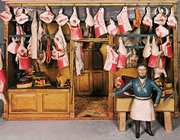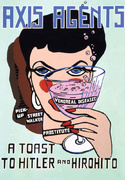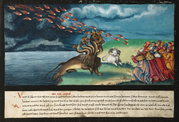
Though adults tend to look back on youth as a time of innocence, childhood is actually terrifying. Kids are always privy to more of the world’s horrors than we realize, and those glimpses of war on the evening news or the mutilation on display in anti-drunk-driving films leave permanent scars on their permeable little minds.
“I often couldn’t distinguish between what was real and what had been a vivid nightmare.”
Richard Littler had a frightening childhood, too, but as a designer and screenwriter, he turned his memories of life in suburban Britain during the 1970s into a haunting and hilarious blog and book about the fictional dystopian town of Scarfolk. Littler mined the dark side of his childhood to create pamphlets, posters, book covers, album art, audio clips, and television shorts—remnants of life in a paranoid, totalitarian 1970s community, where even babies are not to be trusted.
What started as a handful of faux-vintage images for friends’ birthday cards grew into this universe of fake memorabilia, so complete that the Scarfolk concept was recently optioned for a British TV series. Littler borrows liberally from authentic designs of the era to craft his artfully decaying images, which are so familiar at first glance that many have been mistaken for authentic found objects rather than re-creations.
We recently spoke with Littler about the real-world inspiration for Scarfolk and what we can learn from its language of fear.

Top: The cover of a mock-Penguin book on children and hallucinogens. Above: A page from an outdated Scarfolk tourism brochure.
Collectors Weekly: Where did the concept of Scarfolk come from?
Richard Littler: I initially started Scarfolk because I wanted to capture, or rather investigate, the fading memories of my 1970s and early ’80s British childhood. I suffered from night terrors as a kid, and looking back, I often couldn’t distinguish between what was real and what had been a vivid nightmare.
One such memory was of children playing school sports on a railway line: As the children entered a dark tunnel, they’re injured or killed by speeding trains while a brass band played on the embankment. It almost sounds like the plot of a Bunuel film, and for many years I was convinced I had imagined it, especially because everyone I mentioned it to looked at me as if I were insane.
A few years ago, I finally discovered that I hadn’t imagined it—it’s a 1977 public information film called “The Finishing Line,” which was made to deter children from playing near railway lines. The film was screened at my junior school, or around second or third grade in the U.S., where pupils were also shown slide presentations of burn victims to discourage playing with fireworks. “The Finishing Line” caused controversy at the time and was eventually withdrawn. However, its replacement was another violent public information film about a boy called Robbie who loses both legs in a railway accident.
In terms of external inspirations, Scarfolk has all sorts of influences, including Monty Python and Terry Gilliam in particular, George Orwell’s and Yevgeny Zamyatin’s dystopias, the political cartoonists Gerald Scarfe and Ralph Steadman, music by Boards of Canada and The Beatles (whose work from 1967 on I consider “proto-hauntology”), and even the surreal song introductions during live Peter-Gabriel-era Genesis shows.
The conceit is that Scarfolk can never leave the 1970s, even though the rest of the world passes by normally. Perhaps this happens in a neighboring parallel universe, who knows. In practical terms, it means the present day can occasionally leak into the 1970s and vice versa, which is a way to contrast changes in social attitudes and ideas of the past 40 or 50 years.
Collectors Weekly: Do you think of Scarfolk as an alternate version of your childhood?
Littler: Scarfolk is more like a half memory. This means popular or stereotypical imagery from the period is ignored—there are no lava lamps, discos, or garish fashion and interior design. Scarfolk often invokes involuntary memories of long-since forgotten things, which didn’t have a life outside of the period or were taken for granted, like municipal designs, household products, TV station idents, and library music.
The vaguer the memory the better, because it produces this dim sense of recognition, and as you try to piece together the fragments, Scarfolk offers a substitute history. These substitutions are fictional, of course, and sometimes absurdly dark and dystopian.

This 1977 anti-rabies poster (left) inspired Littler’s Scarfolk design (right) warning about the dangers of babies.
Collectors Weekly: Were the ’70s really so dystopian?
Littler: I don’t know how much of my memories are colored by hindsight, but it certainly seems dark in retrospect. Sometimes it was quite literally dark, as well: I grew up during a time of industrial unrest when the country was subject to power cuts and rationing. There were frequent reports of riots and IRA terrorism in the U.K., some of them relatively close to home. I think that such random events undermine one’s sense of security.
This lack of control also affected another area of culture, the preoccupation with the supernatural and occult. Books about UFOs, ghosts, telekinesis, and witchcraft filled the shelves. There wasn’t any skepticism as far I could tell. It was all delivered as fact; perhaps it was a more gullible time. It was as if the fabric of reality was unstable and a poltergeist or UFO could appear at any time.
The term most often applied to Scarfolk is hauntology, which I hadn’t heard of before I started Scarfolk. Hauntology plays in part with the idea developed by Jacques Derrida (via Karl Marx) of the specter of communism haunting Europe after its demise, but it has become something a bit different in popular culture. It recycles aesthetic forms and reflects the clash between the dreams we had of the future in the 1960s through the 1980s versus where we actually are now. But it also looks back, as did 1970s culture, to earlier periods, like pre-Christian paganism and Victoriana, for example.
Collectors Weekly: As a designer, what do you like most about the period’s aesthetic?
Littler: I like the clean lines and simple typefaces of modernism, and I’ve come to appreciate the aesthetic of Brutalist architecture. But it’s not just the period design I’m drawn to—I’m also interested in the pre-digital age and the idea that everything from that period is physically decaying.
Digital images don’t fade after being left on a window sill for a few years; they don’t crack or crumble. An image that goes viral on the Internet, for example, is identical no matter how many copies there are of it. In the pre-digital age, two people may have owned the same book or LP, but there would be idiosyncratic differences between the two physical objects. I have a personal response to most of the artifacts I imitate, and I’m lucky that others have had similar responses.

Two of the album covers Littler produced for Scarfolk.
Collectors Weekly: What’s your typical method for creating Scarfolk graphics?
Littler: I have a couple approaches. The first is to scour the Internet or my own books for an image that appeals to me and then improvise an idea around it. I collect digital imagery of the period for reference—my folder of 1970s images has about 20,000 items in it. In terms of physical objects, I don’t actively collect anything, though I own many publications from the period, particularly comics and books.
The second method is to start with an idea, and then go hunting for the appropriate imagery. This is a much harder process, but it’s necessary for posts that are direct comments on contemporary events and recent news.

Scarfolk designs often play with the modernist aesthetic of actual Penguin covers, like these three above.
Collectors Weekly: Have people mistaken your designs for real artifacts?
Littler: I’ve had mails from people telling me they contacted Penguin, the publisher, to ask where they might buy copies of some of the fake Scarfolk books, like “Children and Hallucinogens.” And there are often cases when people believe a Scarfolk post to be genuine, particularly those posts which elicit knee-jerk emotional reactions. Usually these deal with social issues like race, gender, or the treatment of children, and they haven’t taken in enough of the image to realize that it’s parody or satire. Most Scarfolk readers are very playful and like to string people along for as long as they can get away with it.
I have a soft spot for “Children & Hallucinogens” and “Don’t” because they propelled Scarfolk when I first started the blog, and to date they’re two of the most frequently viewed images. In general, I prefer designs that imitate recognizable period branding, like the Ladybird or Penguin book covers.

Two of the unsettling “How To” books made for Scarfolk.
Collectors Weekly: How does Scarfolk reflect contemporary culture?
Littler: Scarfolk is paranoid and cynical, and often touches on themes such as surveillance and the diminishment of civil rights. To a certain extent, Scarfolk is speculative because it plays with the recent political developments and either subverts them or exaggerates them to the point of absurdity, though that’s becoming difficult with people like Donald Trump and the incumbent British government. Increasingly, there are official actions and statements that come across like they’ve already been created by satirists. It’s becoming hard for us to outdo our sources!
(All Scarfolk images courtesy Richard Littler. For more morbid fun, check out his book, “Discovering Scarfolk,” or follow Scarfolk on Twitter and Facebook. If you buy something through a link in this article, Collectors Weekly may get a share of the sale. Learn more.)











 How the Military Waged a Graphic-Design War on Venereal Disease
How the Military Waged a Graphic-Design War on Venereal Disease
 Baby's First Butcher Shop, Circa 1900
Baby's First Butcher Shop, Circa 1900 How the Military Waged a Graphic-Design War on Venereal Disease
How the Military Waged a Graphic-Design War on Venereal Disease Storybook Apocalypse: Beasts, Comets, and Other Signs of the End Times
Storybook Apocalypse: Beasts, Comets, and Other Signs of the End Times PostersIn 1867, Jules Cheret, inspired by Japanese woodcuts, used the newly-develo…
PostersIn 1867, Jules Cheret, inspired by Japanese woodcuts, used the newly-develo… BooksThere's a richness to antique books that transcends their status as one of …
BooksThere's a richness to antique books that transcends their status as one of … Mari Tepper: Laying it on the Line
Mari Tepper: Laying it on the Line Nice Ice: Valerie Hammond on the Genteel Charm of Vintage Canadian Costume Jewelry
Nice Ice: Valerie Hammond on the Genteel Charm of Vintage Canadian Costume Jewelry How Jim Heimann Got Crazy for California Architecture
How Jim Heimann Got Crazy for California Architecture Modernist Man: Jock Peters May Be the Most Influential Architect You've Never Heard Of
Modernist Man: Jock Peters May Be the Most Influential Architect You've Never Heard Of Meet Cute: Were Kokeshi Dolls the Models for Hello Kitty, Pokemon, and Be@rbrick?
Meet Cute: Were Kokeshi Dolls the Models for Hello Kitty, Pokemon, and Be@rbrick? When the King of Comedy Posters Set His Surreal Sights on the World of Rock 'n' Roll
When the King of Comedy Posters Set His Surreal Sights on the World of Rock 'n' Roll How One Artist Makes New Art From Old Coloring Books and Found Photos
How One Artist Makes New Art From Old Coloring Books and Found Photos Say Cheese! How Bad Photography Has Changed Our Definition of Good Pictures
Say Cheese! How Bad Photography Has Changed Our Definition of Good Pictures Middle Earthenware: One Family's Quest to Reclaim Its Place in British Pottery History
Middle Earthenware: One Family's Quest to Reclaim Its Place in British Pottery History Fancy Fowl: How an Evil Sea Captain and a Beloved Queen Made the World Crave KFC
Fancy Fowl: How an Evil Sea Captain and a Beloved Queen Made the World Crave KFC
For more insights please reread
Brilliant graphics! I couldn’t help but think about Welcome to Nightvale, reading this. And of Stranger Things to a certain level. The vision of dystopian, time-distorted towns in the 70’s and 80’s does seem to be something that’s trapped in the collective consciousness of this generation…
great job again hunter — currently reading “the face that must die” by ramsey campbell — their lives could have paralleled — overbearing mothers/absent fathers etc etc — it does make one so thankful to have been dropped off (either via the stork, aliens or a higher supreme being) in a loving home with for the most part “sanity” or if not that — a lot of good humor